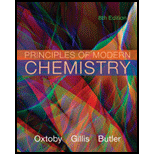
Concept explainers
(a)
Interpretation: The relative molecular mass of
Concept Introduction: The molecular mass of any compound can be calculated by taking sum of atomic masses of all the elements present in it. For example, the molecular mass of AB can be calculated as follows:
Here, A and B are atoms of two different elements.
(b)
Interpretation: The relative molecular mass of
Concept Introduction: The molecular mass of any compound can be calculated by taking sum of atomic masses of all the elements present in it. For example, the molecular mass of AB can be calculated as follows:
Here, A and B are atoms of two different elements.
(c)
Interpretation: The relative molecular mass of OsO4 needs to be determined.
Concept Introduction: The molecular mass of any compound can be calculated by taking sum of atomic masses of all the elements present in it. For example, the molecular mass of AB can be calculated as follows:
Here, A and B are atoms of two different elements.
(d)
Interpretation: The relative molecular mass of H2SO4 needs to be determined.
Concept Introduction: The molecular mass of any compound can be calculated by taking sum of atomic masses of all the elements present in it. For example, the molecular mass of AB can be calculated as follows:
Here, A and B are atoms of two different elements.
(e)
Interpretation: The relative molecular mass of Ca3Al2(SiO4)3needs to be determined.
Concept Introduction: The molecular mass of any compound can be calculated by taking sum of atomic masses of all the elements present in it. For example, the molecular mass of AB can be calculated as follows:
Here, A and B are atoms of two different elements.
Want to see the full answer?
Check out a sample textbook solution
Chapter 1 Solutions
Bundle: Principles of Modern Chemistry, 8th + OWLv2, 1 term (6 months) Printed Access Card
- What is the lone pair or charge that surrounds the nitrogen here to give it that negative charge?arrow_forwardLast Name, Firs Statifically more chances to abstract one of these 6H 11. (10pts total) Consider the radical chlorination of 1,3-diethylcyclohexane depicted below. 4 • 6H total $ 4th total 21 total 4H total ZH 2H Statistical H < 3°C-H werkst - product bund abstraction here leads to the mo favored a) (6pts) How many unique mono-chlorinated products can be formed and what are the structures for the thermodynamically and statistically favored products? Proclict 6 Number of Unique Mono-Chlorinated Products f Thermodynamically Favored Product Statistically Favored Product b) (4pts) Draw the arrow pushing mechanism for the FIRST propagation step (p-1) for the formation of the thermodynamically favored product. Only draw the p-1 step. You do not need to include lone pairs of electrons. No enthalpy calculation necessary 'H H-Cl Waterfoxarrow_forward2. (a) Many main group oxides form acidic solutions when added to water. For example solid tetraphosphorous decaoxide reacts with water to produce phosphoric acid. Write a balanced chemical equation for this reaction. (b) Calcium phosphate reacts with silicon dioxide and carbon graphite at elevated temperatures to produce white phosphorous (P4) as a gas along with calcium silicate (Silcate ion is SiO3²-) and carbon monoxide. Write a balanced chemical equation for this reaction.arrow_forward
- this is an organic chemistry question please answer accordindly!! please post the solution in your hand writing not an AI generated answer please draw the figures and structures if needed to support your explanation hand drawn only!!!! answer the question in a very simple and straight forward manner thanks!!!!! im reposting this please solve all parts and draw it not just word explanations!!arrow_forward2B: The retrosynthetic cut below provides two options for a Suzuki coupling, provide the identities of A, B, C and D then identify which pairing is better and justify your choice. O₂N. Retro-Suzuki NO2 MeO OMe A + B OR C + Darrow_forwardthis is an organic chemistry question please answer accordindly!! please post the solution in your hand writing not an AI generated answer please draw the figures and structures if needed to support your explanation hand drawn only!!!! answer the question in a very simple and straight forward manner thanks!!!!! im reposting this please solve all parts and draw it not just word explanations!!arrow_forward
 Chemistry: Principles and ReactionsChemistryISBN:9781305079373Author:William L. Masterton, Cecile N. HurleyPublisher:Cengage Learning
Chemistry: Principles and ReactionsChemistryISBN:9781305079373Author:William L. Masterton, Cecile N. HurleyPublisher:Cengage Learning Chemistry: The Molecular ScienceChemistryISBN:9781285199047Author:John W. Moore, Conrad L. StanitskiPublisher:Cengage Learning
Chemistry: The Molecular ScienceChemistryISBN:9781285199047Author:John W. Moore, Conrad L. StanitskiPublisher:Cengage Learning Chemistry: Principles and PracticeChemistryISBN:9780534420123Author:Daniel L. Reger, Scott R. Goode, David W. Ball, Edward MercerPublisher:Cengage Learning
Chemistry: Principles and PracticeChemistryISBN:9780534420123Author:Daniel L. Reger, Scott R. Goode, David W. Ball, Edward MercerPublisher:Cengage Learning


